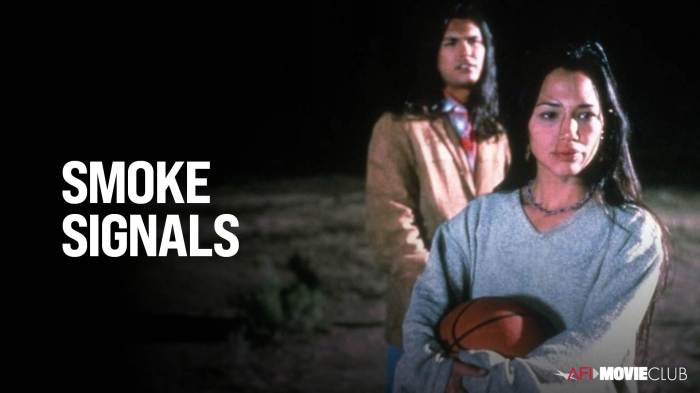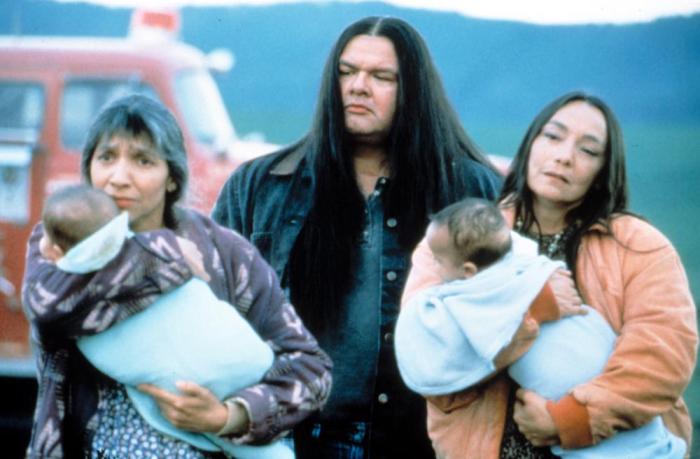Quotes from the movie smoke signals – “Sometimes you have to go back to go forward.” This evocative quote from the movie Smoke Signals encapsulates the film’s exploration of identity, family, and loss. Join us as we delve into the rich tapestry of quotes, characters, and cultural insights that make this film a poignant and thought-provoking cinematic experience.
Smoke Signals, directed by Chris Eyre, is a groundbreaking film that celebrates Native American culture while confronting the challenges it faces. Through its memorable characters and powerful storytelling, the film invites us to reflect on our own journeys of self-discovery and the enduring bonds that connect us.
Quotes and Themes

The opening quote, “Sometimes you have to go back to go forward,” encapsulates the film’s central theme of reconciliation and self-discovery. Victor’s journey forces him to confront his past and reconnect with his Spokane heritage, ultimately leading to personal growth and a deeper understanding of himself.
Other notable quotes include:
- “You can’t go home again because home has changed.” – This quote reflects the film’s exploration of the complexities of identity and the challenges of returning to one’s roots.
- “We’re all just walking around trying to figure out who we are.” – This quote highlights the film’s universal themes of self-discovery and the search for belonging.
- “Loss is never easy, but it’s a part of life.” – This quote underscores the film’s portrayal of grief and the resilience of the human spirit.
A quote that particularly resonates with me is “Sometimes you have to let go of the past to move on with the future.” This quote speaks to the importance of forgiveness and the need to release the burdens of the past in order to embrace the possibilities of the future.
Character Development

Victor Joseph
Victor is the film’s protagonist, a young Spokane Indian man who returns to his reservation after being away for many years. Through his journey, he grapples with issues of identity, loss, and the search for his place in the world.
Thomas Builds-the-Fire
Thomas is Victor’s father, a respected elder on the reservation. He is a source of wisdom and guidance for Victor, helping him to reconnect with his Spokane heritage and come to terms with his past.
Arnold Joseph
Arnold is Victor’s uncle, a former alcoholic who has struggled with his own demons. Arnold’s relationship with Victor is complex and strained, but ultimately they find a way to reconcile and support each other.
| Character | Motivations | Contribution to Plot |
|---|---|---|
| Victor Joseph | To reconnect with his Spokane heritage, find his place in the world, and overcome his grief | Drives the main plot and provides the film’s emotional core |
| Thomas Builds-the-Fire | To guide Victor on his journey of self-discovery and help him reconnect with his past | Provides wisdom and support, grounding the film in Spokane culture |
| Arnold Joseph | To make amends for his past mistakes and find redemption | Creates tension and conflict, but ultimately contributes to Victor’s reconciliation with his family |
Cultural Context

The Spokane Indian Reservation setting is central to the film’s themes and characters. The reservation provides a backdrop for Victor’s journey of self-discovery and his exploration of his Spokane heritage.
The film portrays Native American culture with authenticity and respect. It highlights the challenges faced by Native Americans, including poverty, alcoholism, and cultural displacement.
Victor’s experiences reflect broader cultural issues faced by Native Americans. His struggle to find his place in the world is a reflection of the challenges faced by many Native Americans who seek to balance their traditional heritage with the modern world.
Symbolism and Imagery
Smoke Signals
Smoke signals are a recurring symbol throughout the film, representing communication, connection, and memory. They are used to convey messages between characters, both literally and metaphorically.
Flashbacks and Dream Sequences
The film uses flashbacks and dream sequences to explore the characters’ pasts and inner worlds. These sequences provide insights into their motivations and struggles.
Cinematography and Editing
The film’s cinematography and editing contribute to its emotional impact. The use of long takes and slow motion creates a contemplative atmosphere, while the juxtaposition of different shots and perspectives enhances the film’s themes of memory and reconciliation.
Filmmaking Techniques

Non-Linear Narrative
The film employs a non-linear narrative structure, which allows it to explore the characters’ pasts and presents simultaneously. This technique creates a sense of complexity and depth.
Voiceover
The film uses voiceover to provide insights into the characters’ thoughts and feelings. This technique adds a layer of intimacy and allows the audience to connect more deeply with the characters.
Music and Sound Effects
The film’s music and sound effects are used to create atmosphere and enhance the emotional impact. The use of traditional Native American music adds to the film’s authenticity and cultural significance.
FAQ Corner: Quotes From The Movie Smoke Signals
What is the significance of the opening quote, “Sometimes you have to go back to go forward”?
This quote suggests that sometimes it is necessary to revisit the past in order to gain a clearer understanding of the present and move forward with greater clarity and purpose.
How does the film portray the relationship between Thomas Builds-the-Fire and Arnold Joseph?
The film depicts a complex and evolving relationship between Thomas and Arnold, who are both struggling with personal and cultural challenges. Initially estranged, they gradually learn to connect and support each other on their respective journeys.
What is the symbolism of the smoke signals throughout the film?
The smoke signals serve as a powerful symbol of communication, connection, and cultural heritage. They represent the characters’ attempts to bridge divides, heal wounds, and find their place in the world.